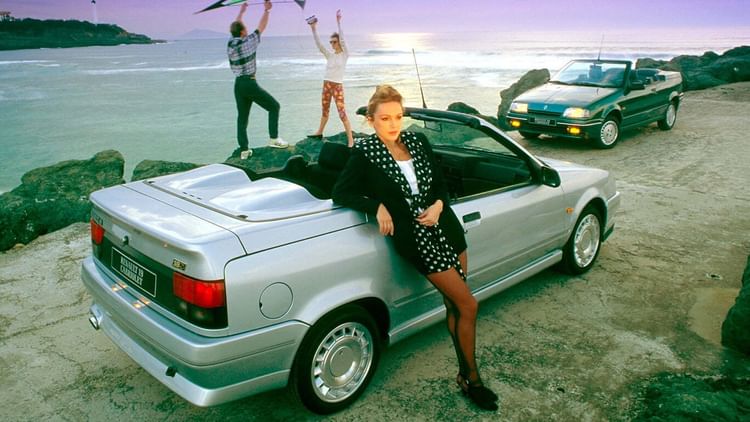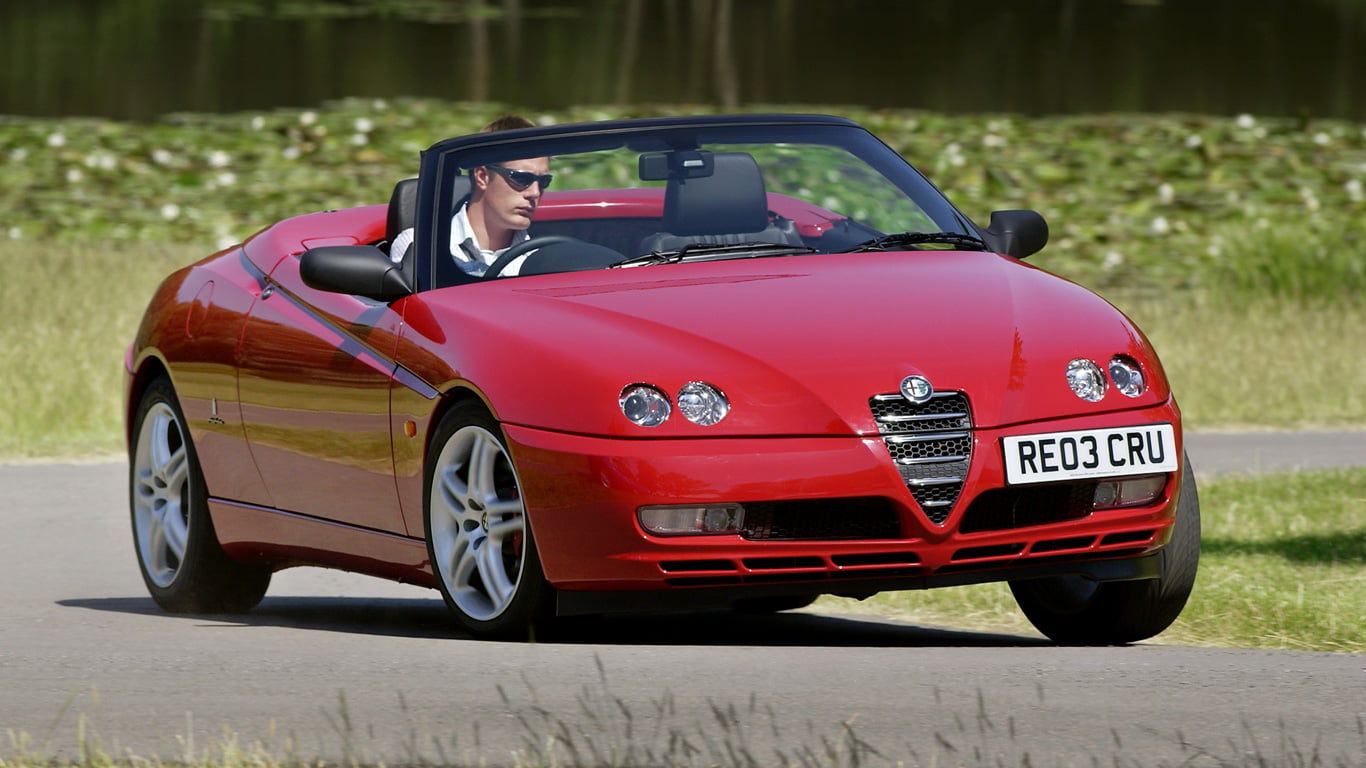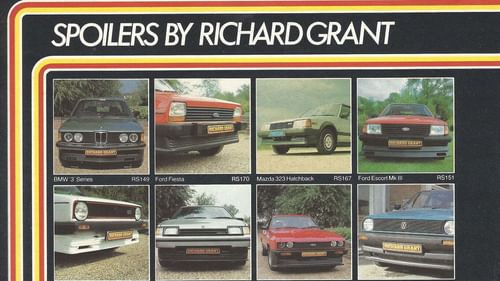Three ways to get your top off this summer

Will you lot behave yourselves. We're talking about cars here...
Sheesh...a couple of hot days and you guys turn into Hugh Hefner. Any more nonsense and I'll turn the fire hoses on you, assuming that the annual hosepipe ban isn't yet in force.
Talking about predictable things, keep your eyes peeled for the appearance of the annual '10 best convertibles you can buy' features. Actually, you needn't bother – they'll just feature exactly the same cars as last year.
This piece is going to be different. It won't include the likes of the Mazda MX-5, Boxster and Saab 900 convertible. That would be boring and predictable. So I'm going to do what I usually do – be boring and predictable in a different way and pick a few worthy ragtops that deserve their, ahem, day in the sun.
They're all good cars, and in these days of straitened finances you'll be glad to know that you can treat yourself to all three of them and still have change from £10,000. And that, me buckos, is good value for anyone's money.
Let's start off with something French. Sorry, Gavin, it's not a Peugeot 306 Cabriolet...
Renault 19 16V cabriolet – guide price £2,000
The hard top versions of Renault's hot 19 (well, it was hot for its day – 137bhp is barely enough to power the air con in today's hot hatches) were highly regarded back in the early 90s. They looked good (especially the three-door hatch in Sports Blue), handled and rode extremely well, had reasonable straight-line performance and few discernible flaws.
But, to paraphrase Master Yoda, there was another – a handsome cabriolet that was introduced in 1992, around the same time as the 19 range received a midlife facelift. Consequently, almost all of the cabrios produced were based on the phase 2 bodyshell. It's said that a few phase 1 cabriolets were built – and there's certainly photographic evidence of such a beast – but I've never seen one in the metal or the classifieds.
Although the 19 doesn't quite pull off the trick of convincing the viewer that it's a cabrio by design rather than conversion, the detailing (the bonnet scoop, the double bubble rear deck) draws in the eyes and the overall shape is agreeable enough.
Plumping for the 16V model means that you get alloys, attractive sports seats and a good level of equipment. You don't, however, get an electric roof, but that's no hardship. The manual roof is easy to stow and raise, the lack of a motor saves a bit of weight and means that there's one less thing to go wrong. And, no, that's not a dig at 90s French car electrics. Well, perhaps just a little one...
[caption id="attachment_22316" align="aligncenter" width="1366"] © Renault[/caption]
© Renault[/caption]
The interior is quite airy with the roof up, there's a reasonable amount of room in the back and the driving position is good. It drives well, too. The cabrio has less torsional rigidity than its fixed-roof siblings but retains much of their sharpness and grip. The power-assisted steering is nicely weighted and gives good feedback, and the ride successfully straddles the boundary between firm and comfortable. You should, however, expect some shake and rattle. Performance is crisp, but the 16V engine needs a good lungful of air in order to give of its best. It's good, then, that it's a willing revver. It all adds up to a car that will happily waft along yet be capable of making swift progress when required.
The 19 16V cabrio was only produced for a little over two years and few remain on UK roads - only twelve were taxed as at the end of 2014, according to how many left. That number should rise a little in the summer, but by any standards it's a rare car. I'd normally advise people to buy a convertible in the winter when prices are lower, but that advice gets thrown out with the bathwater when it comes to cars as rare as this. So if you see a good one, don't hesitate...
I like the 19, but you might prefer to lose the rear seats and gain some extra oomph. That being so, let's head back to Blighty for my next selection.
Nope, it's not an MG, albeit a well cared for MGTF 160 wouldn't be a bad choice – just make sure that it's had an uprated head gasket fitted.
Perhaps a Lotus, then? The boys from Hethel have unquestionably offered some great open top cars over the years. The baby Elan and Elise are a mite too expensive for our budget, but a decent Elan M100 can still be picked up for reasonable money. I've already written about the M100, however, so it's only right that another unclaimed treasure gets its turn in the spotlight.
And talking about illumination, guess where the road leads now. Yup, it's Blackpool, spiritual home of TVR. And I won't be leaving empty handed.
If money were no object, I'd plump for a Tamora, but our budget just won't stretch that far. Pity. The budget can just about stretch to an S, but I'll save some wedge by choosing a wedge...
TVR Tasmin/280i – guide price £4,000
[caption id="attachment_22317" align="aligncenter" width="1366"] © TVR[/caption]
© TVR[/caption]
The V6 version of TVR's 80s mainstay was, and still remains, in the shadows of her V8-powered, road-burning sisters. And if outright performance is your thing then the V8 is where it's at. But a good V8 wedge is out of our budget, so it's a V6 for us. And that's no bad thing.
Introduced at the 1980 Geneva Motor Show, the Tasmin's bold styling made an immediate impression. Some thought that the Peter Winterbottom (the same Peter Winterbottom who styled the 1970s Lotus Elite and Eclat) penned shape was bold and modern, while others reached a less favourable verdict. You pays your money and you takes your choice...
Motive power was supplied by a 2.8-litre V6 Ford 'Cologne' unit, pumping out 160 bhp – reasonable by the standards of the day. Performance is brisk – rest to 60 takes around 7.5 seconds and the top speed is a smidgeon over 120mph. Do you really need any more than that? Really?
Handling is generally very good. The gearing of the Tasmin's unassisted steering is perhaps a little on the high side, but it weights up nicely at speed. Cornering attitude is neutral, although there is some body roll. The Tasmin will ultimately slip into gentle oversteer if provoked, but lacks the ultimate tail-out drama of its V8 siblings. On public roads, that's a good thing.
The design of the dashboard might, to some eyes, resemble something Le Corbusier might have come up with after a glass of wine too many, but it's all very practical and efficient. Comfort levels, however, are only so-so. There's a curious lack of foot room, the steering wheel isn't adjustable, smaller drivers won't appreciate the low seating position and tall ones may feel that their bonce is in rather too close proximity to the roof.
Ah yes, the roof. The TVR designers excelled themselves here, coming up with a roof that has two separate sections. The centre section is rigid, like a targa top, whereas the rear section is a more traditional folding design. You can remove the targa section without having to fold away the rear section, so the Tasmin is both a targa and a convertible. It was an ingenious design back in 1980, and it still impresses today.
[caption id="attachment_22318" align="aligncenter" width="1366"] © Newspress[/caption]
© Newspress[/caption]
Although TVRs don't have the best reputation for reliability, Tasmin ownership needn't be entered into with trepidation. The parts-bin nature of the Tasmin helps to ensure that parts availability is good for such a low-volume car, and there's an enthusiastic and knowledgeable owners' community. As with all cars, it's just a matter of doing your homework, carefully vetting proposed purchases and being prepared to walk away rather than take a risk.
There are faster and better looking convertibles than the Tasmin, but most can't match its character or ability to put a smile on your face – something that you'll be reminded of every time you venture out on a sunny day.
Two down, one to go.
For my last pick, I'm going to head south to warmer climes. After partaking of some home-cooked pasta and a little chianti, I'm going to gaze longingly at the flanks of a beautiful Italian. No, not a youthful Sophia Loren, but something that stirs the emotions in a slightly different way...
Alfa Spider – guide price £3,500
[caption id="attachment_22314" align="aligncenter" width="1366"] © Alfa Romeo[/caption]
© Alfa Romeo[/caption]
Right, here's my sales pitch. It's an Alfa, styled by Pininfarina and comes with either a twin-spark 4-pot or the even more glorious Busso V6.
And that's it. Job done.
Still here? Really? Blimey. I thought you'd all be scouring the classifieds, raiding your piggy banks, selling non-essential relatives and generally doing whatever it takes to buy a Spider. But since you're still favouring me with your company, I suppose I'd better tell you some more.
Let's start with a little history. No, don't yawn. It's really not that bad.
The Spider was essentially a replacement for the much-loved and more than slightly venerable Duetto (I'll use its original name for ease of reference). The Duetto had a long and successful career, but by the late 80s it was becoming clear to Alfa that not even re-runs and VHS special editions of The Graduate would be able to sustain its appeal indefinitely. What was needed was a new, radically different car to ignite the slumbering passions of would be Alfisti. That car was the Spider.
When it was launched at the 1995 Geneva Motor Show, the Spider (and its fixed-head twin, the GTV) caused the assembled motoring media to draw a sharp intake of breath. Gone were the soft curves of the Duetto, replaced by crisp, angular and, above all, modern lines. Under the skin, the classic rear-wheel drive layout of the Duetto was eschewed in favour of driven front wheels.
The changes had also been rung under the bonnet. The Duetto had been offered with a variety of engine options over the years, ranging from 1.3- to 2.0-litres. The Spider, however, was available from launch with Alfa's sonorous 3.0-litre Busso V6 unit as well as the well proven 2.0-litre twin-spark powerplant. In time, a 1.8-litre twin-spark unit would be added to the range, and late model V6 Spiders would receive the final 3.2-litre, 24 valve incarnation of the Busso engine. Which is best? They all deliver good performance and sound great, but if you live near a tunnel then the Busso is the one to get...
So the Spider goes well, but how does it handle? Pretty well, as it turns out. As you'd expect there's some understeer (less pronounced in the 4-cylinder versions), but grip and handling are both good for a 90s ragtop. There's some scuttle shake, of course, and the ride is firm but not harsh. The steering is quite direct, which I like, but the turning circle suffers accordingly. Nobody buys a Spider for its low-speed manoeuvrability, of course, but if that's an essential feature for you then this link will lead you right to your ideal car... No need to thank me. I'm here to help.
[caption id="attachment_22313" align="aligncenter" width="1366"] © Alfa Romeo[/caption]
© Alfa Romeo[/caption]
Like the exterior, the interior tends to polarise opinions, especially on cars with red leather seats and door facings. That said, the cabin is a comfortable enough environment once you've managed to find the ideal driving position. It's an Italian car so the need for some faffing about with the seat and steering wheel adjusters comes as standard. And you wouldn't have it any other way, would you?
Although the Spider ceased to be produced almost a decade ago, you'll still find plenty of them on UK roads. Likewise, there's no shortage of examples up for sale. Prices can vary considerably, but you should be able to pick up a nice twin-spark for under £4,000. You'll pay less in winter, of course, but do you really want to wait that long? Nope. I thought not.
And that's it. Three fine cars for summer. You can use the Alfa all year round if you want (it's not only newer than the others, it's also galvanised), but I think it's something to be savoured rather than gorged upon.
There are plenty of other great (and great value) convertibles and cabriolets that don't often make the so-called 'best of' lists – the Fiat Barchetta, the Peugeot 306 Cabriolet, the TR7 convertible and so on. So here's my prescription for a good summer: follow your heart instead of the crowd and find the convertible that's right for you. Add some sun, drop the hood and feel your grin grow ever wider. It's as easy as that.
Some of you will already know that feeling. As for the rest of you, what are you waiting for? A written invitation? Get to it, peeps. It's later than you think.





